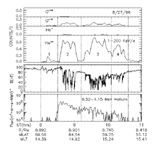
Theodore A. Fritz, Jiasheng Chen, and Robert B. Sheldon
Center for Space Physics, Boston University, 725 Commonwealth Avenue,
Boston, MA 02215 USA
E-mail: fritz@bu.ed
ABSTRACT
New observations from the NASA GGS POLAR satellite of cusp energetic particle [CEP] events indicate that a mechanism(s) in the dayside cusp can accelerate the solar wind plasma to 100s and 1000s of kiloelectronvolts energies. The mechanism seems to be active much of the time but is impulsive in nature with an event having a lifetime of 45-60 minutes. This mechanism is capable of producing an energetic particle layer that straddles the magnetopause along the flanks of the magnetosphere. These energetic particles can enter the magnetosphere as a result of gradients in the magnetic field and the resultant drifts they cause; ions entering along the dawn flank drifting to the west and electrons entering along the dusk flank drifting east will carry a current. Since these particles will drift to distances less than six earth radii in the nightside equatorial plane, their variations in time probably control the dynamics of the magnetosphere in the range 6 < L < 13 and these particles are probably the source of the plasma sheet energetic particle population. This result has the potential to be a new paradigm for the way we view the dynamics of the magnetosphere.
INTRODUCTION
The source, energy distribution, and radial structure of energetic ions and electrons in the radiation belts is well explained by the process of radial diffusion. Radial transport of charged particles by diffusion processes driven by fluctuations in the geomagnetic field or in the geoelectric field from a reservoir of particles in the outer magnetosphere has been studied by many authors (e.g., Tverskoy, 1965; Cornwall, 1971; Spjeldvik and Fritz, 1978). Such transport occurs while conserving the first and second adiabatic invariants of the particles. For ions these radial diffusive transport codes are coupled with loss processes such as charge exchange and coulomb collisions. Published work usually begins with a measured energy spectrum of the ions and/or electrons in the range of L > 7 as the input source of the subsequent radial diffusion (Tverskoy, 1965; Spjeldvik and Fritz, 1978). In this paper observations from the POLAR satellite will be presented and discussed which offer a new source associated with the high altitude polar cusps for energetic particles which compose the source spectrum of the outer magnetosphere. These observations conclusively establish the existence of the source in the cusp to accelerate ions to energies of 100s and 1000s of keV with phase space densities equivalent to those of the trapped fluxes in the geostationary orbit region of the magnetosphere.
We then spectulate that these CEP fluxes could be responsible for much of the dynamics of the radiation belts and inner magnetosphere. These CEP energetic particles can stream out of the cusp and form a layer of energetic particles on the magnetopause. Tverskoy (1970) has postulated the entry of such a population of energetic ions along the dusk flank and has developed a complete theory and description of the functioning of magnetospheric processes based on this initial condition. The theory is equivalent to the existence of a cross-tail steady-state electric field.
POLAR OBSERVATIONS
Using observations from the POLAR satellite, Chen et al. (1997,1998) and Chen
and Fritz (1998a,b) have shown that energetic particles of recent solar
wind/magnetosheath origin are energized in situ in the high altitude polar cusp.
POLAR was launched on February 24, 1996 into a 1.8 RE by 9
RE polar orbit which
provided an excellent and unique opportunity to investigate energetic particles
in the high altitude polar cusp region. An example of such a cusp energetic
particle or CEP event is shown in Figure 1 (Fritz et al., 1999).
 |
Fig. 1. An example of the CEP event on August 27, 1996. The panels from top to bottom show the counting rate for O<+3, O>+2, He+, He++ versus time , the corresponding variation of the local geomagnetic field, and the flux of the 0.52 - 1.15 MeV helium, respectively, where the vertical dashed lines mark the four different regions comprising individual CEP events. The distance of POLAR from the Earth (in RE), the magnetic latitude (MLAT), and the magnetic local time (MLT) are shown at the bottom of the figure. (Fritz et al., 1999) |
On August 27, 1996, the POLAR satellite was inbound from its apogee of 9 Earth
radii [RE]
situated directly over the northern polar cap region of the Earth. The data
presented are of the measured intensity of protons, helium and oxygen ions with
energy between 1 keV and 1.2 MeV and we see that fluxes of the very energetic
ions are found in a region which we associate with the high altitude, polar
magnetic field cusp region. There are enhanced fluxes associated with those
ions of solar wind origin (He++ and O>+2). Each of these CEP events lasts up to
40 or 50 minutes and the period during which they were observed by POLAR in this
case was over two hours from 8.5 UT to 10.5 UT. In each occurrence of the CEP
fluxes the magnetic field becomes depressed and extremely variable. There are
no equivalent intensities of such energetic ions present upstream of the
magnetopause in the interplanetary medium (Chen and Fritz, 1998a,b). This can
be seen in Figure 2 which shows the measured proton energy spectra in the cusp during two different CEP events and the comparsion of these fluxes to those
measured at the same time by the Geotail satellite EPIC experiment (Williams
et al., 1994).
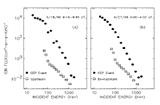 |
Fig. 2. Comparsions of simultaneous CEP spectra and those measured by the Geotail EPICS instrument (a) upstream of the bow shock and (b) downstream from the bow shock in the magnetosheath (Chen and Fritz, 1998b). |
Figure 2a presents a case when Geotail was upstream of the bow
shock and connected to it magnetically while Figure 2b presents a case when Geotail was downstream in the magnetosheath between the bow shock and
magnetopause. Note that in both of these cases the CEP fluxes are about two
orders of magnitude larger than those either upstream or downstream from the bow
shock. Chen and Fritz (1998b) also demonstrated that the intensity of the very
energetic helium ions associated with CEP events is correlated with the
intensity of the magnetic turbulence (Figure 3) occurring at the same location and time. Both of these observational facts argue very strongly for the local
nature of the source of the acceleration of these CEP ion fluxes. The depressed
magnetic field, indicative of a diamagnetic cavity, must be integral to the CEP
energization process.
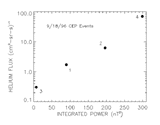 |
Fig. 3. The intensity of the measured 0.52-1.15 MeV helium ion fluxes plotted against the measured magnetic field spectral noise intensity during the CEP event of September 18, 1996 (Chen and Fritz, 1998b). |
During the first eight months of POLAR operations about
70 CEP events were observed. These CEP events are found only near local noon
when POLAR is near its apogee (Chen et al., 1998). The intensity of
these CEP particle fluxes are comparable to those observed in the outer
magnetosphere. This can be seen by constructing the energy spectrum of
protons from a combination of POLAR sensors over a very extended energy
range and comparing this spectrum to one measured by the geostationary
satellite ATS-6 near the midnight meridian for equatorially mirroring
particles (Fritz et al., 1977). The comparison is shown in Figure 4. This is the same ATS-6 spectrum that was used by Spjeldvik and Fritz (1978) as their source spectrum in their radial diffusion modeling. The intensity of energetic electrons is seldom elevated during CEP but Sheldon et al. (1998) has shown that energetic
electrons are observed in the cusp. Is there evidence of a layer of
energetic particles on the magnetopause that such a connection would require?
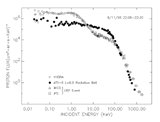 |
Fig. 4. Composite figure showing the proton energy spectrum measured by the POLAR satellite in the high altitude cusp during a CEP event and by the ATS-6 satellite at the geostationary orbit on the nightside of the Earth. |
A LAYER OF ENERGETIC PARTICLES ON THE FLANKS OF THE MAGNETOPAUSE
There have been many reports of an energetic particle layer in the magnetosheath
region between the magnetopause and the bow shock particularly along the flanks
of the magnetosphere (eg, Meng and Anderson, 1970). Sarris, Krimigis, and
Armstrong (1976) reported that bursts of energetic particles of non-thermal
origin both within and outside of the magnetotail are a semipermanent feature
with energies ranging beyond 4.5 MeV for ions and 1 MeV for electrons. Baker and
Stone (1978) observed a layer of energetic electrons [E > 200 keV] to be
persistently present [97 % of crossing, > 70 % of the time] in the
range -10 RE > XSM > -40 RE. The electrons were streaming tailward along the local magnetosheath field lines. This layer appears to completely envelop the magnetopause and has a roughly annular cross-section. They found that fluxes of these particles in the plasma sheet were lower than those in the adjacent magnetopause energetic particle layer. Williams et al. (1985) and Mitchell et al. (1987) analyzed magnetopause crossings of the ISEE-1 satellite along the dusk and dawn flanks and found that the occurrence and width of fluxes of > 25 keV ions which they ascribe to a boundary layer increased with increasing distance away from the subsolar region becoming a tailward flow with the particles appearing on both sides of the "magnetopause". Figure 5 is a reproduction of a figure from Williams et al. (1985) showing that the energetic particles, and ions in particular, disregard the presence of the magnetopause as defined by the magnetic field and magnetosheath plasma. In the magnetosheath the energetic particle intensities are field aligned and anti-sunward. Since ISEE-1 was a satellite with a low inclination orbit, this is what would be anticipated from a cusp source at high latitudes and near local noon. Are there further indications of a dayside energetic particle source?
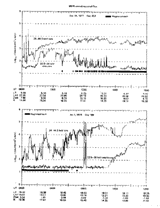 |
Fig. 5. The ISEE-1 Medium Energy Particle Instrument (MEPI) omnidirectional ~ 30-keV ion and electron flux-time histories for the two low latitude boundary layer crossings. In the top panel (December 19, 1977), ISEE-1 travels from ~ 14 RE to ~ 20 RE (radial distance R, ZSM, LATSE, and local time appear below the panel) The fluxes increase at ~ 0900 UT at the lobe plasma sheet boundary, and the ion fluxes remain high throughtout the boundary layer and into the sheath. The electron flux drops by a factor ~ 3 in the boundary layer, and again to detector background in the sheath. The solid bar indicates periods of magnetosheath measurements. The three sharp spikes between 0800 and 0830 UT in the ions are due to interference from another ISEE-1 instrument. The bottom panel shows the equivalent data for July 7, 1978. In this pass ISEE-1 travels from the sheath into the magnetosphere, encountering the magnetopause at ~ 0700 UT and remaining earthward of the magnetopause thereafter except for two brief encounters at ~ 0745 UT. In this pass, the electron detector remains at background throughtout the sheath and boundary layer, rising only after 0930 UT. The ions are bursty in the sheath, rise in the boundary layer, and rise further in the plasma sheet. The vertical spikes just after 0800 UT are caused by an instrument calibration sequence. (from Williams et al., 1985) |
HIGH-LATITUDE BUT LOW-ALTITUDE OBSERVATIONS
The orbit of the POLAR satellite has seldom crossed the magnetopause into the
magnetosheath proper. Therefore most observations of magnetosheath plasma by
POLAR are associated with entry of that plasma into the high-altitude polar
cusp. As this solar wind plasma is rammed into the cusp, it appears that
diamagnetic cavities of large dimensions are produced as the magnetic field
drops from values of ~ 100 nanotesla (nT) to very small values (~ 0 nT). The
turbulence associated with this process appears to accelerate ions and probably
electrons with energies exceeding many MeV. These cavities appear to have a
finite lifetime (many 10s of minutes). The energetic particles produced in this
manner "leak" out of both ends of the mirror geometry. Those emitted in the
sunward direction form the energetic particle layer noted above. Those emitted
toward the Earth will mostly mirror and be reflected from the stronger magnetic
fields. Some will reach low altitudes where they have been reported (Frank, Van
Allen and Craven, 1964; Fritz, 1970; Blanchard et al., 1998). Figure 6 reproduces a figure in Frank, Van Allen and Craven (1964) showing the contours of constant average intensity of the fluxes of > 40 keV electrons precipatating into the atmosphere. The maximum on the dayside near local noon is clear and
implies a source for these particles at that location. Fritz (1970) studied the
location of the high latitude trapping boundary and the occurrence of regions of
particle distribution isotropy over the upper hemisphere. He found an expanded
region of enhanced particle precipatation near local noon again implying a
source at this location. Blanchard et al. (1998) presented examples
of very energetic particle precipitation [> 105 keV and > 1.05 MeV electron
fluxes] at high latitudes near local noon well separated from the trapping
boundary. Although Blanchard et al. (1998) argued for magnetopause
scattering of particles drifting from the nightside, a dayside cusp
source is a much more straightforward explanation of their observations.
Has POLAR observed any evidence of the existence of fluxes of such ions
or electrons present outside the classical cusp?
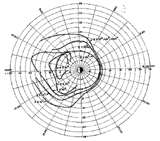 |
Fig. 6. A summary of the median omnidirectional intensities of electrons (E > 40 keV) precipitated into the atmosphere as displayed in a L local time coordinate system. (from Frank, Van Allen, and Craven, 1964). |
FURTHER EVIDENCE FROM THE POLAR ENERGETIC PARTICLE INSTRUMENT
In a study still in progress POLAR has observed very energetic ions near the
cusp which demonstrate a variable energy dispersion signature. Two examples
are shown in Figure 7 of northbound passes, and two examples are shown
in Figure 8 of southbound passes through the polar cusp.
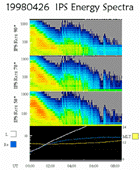 |
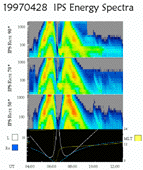 |
Fig. 7. Northbound POLAR satellite passes (a) on April 28, 1997 and (b) on April 26, 1998 showing the energetic ion spectra for three sensor angles of the CEPPAD Imaging Proton Spectrometer with respect to the satellite spin. Note the energy dispersion signatures beginning in time with ion energies above 1 MeV showing dispersion of only a few minutes in some cases to hours in others. |
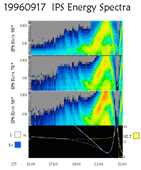 |
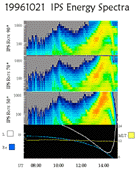 |
Fig. 8. Southbound POLAR satellite passes (a) on September 17, 1996 and (b) on October 21, 1996 showing the energetic ion spectra for three sensor angles of the CEPPAD Imaging Proton Spectrometer with respect to the satellite spin. Note the energy dispersion signatures beginning in time with ion energies close to 1 MeV with dispersion lasting for more than one hour in some cases. |
Note in both cases a series of energy dispersed ion signatures are observed in which the highest energy ions (approaching or exceeding one MeV in many cases) are seen first regardless of the direction of the satellite. Some of these signatures have time durations exceeding one hour. This time difference represents travel times of 800 RE if time-of-flight is used for the difference between one MeV and 20 keV. These times are comparable to the gradient drift period in a dipole field at L = 8. More significant is that the time associated with the dispersion signature is variable ranging from as short as a few minutes to more than one and a half hours. These features are observed whenever POLAR is near local noon between the trapping region of the radiation belt at that location and the cusp. We interpret the time scale of the energy dispersion to be that of the CEP event itself. Multiple occurrences of these dispersions signatures are observed almost on every POLAR pass when the satellite is within a few hours of local noon and between the trapping region and the cusp. They most likely represent the leakage of the higher energy particles from the trap associated with individual CEP events. Are there other energetic particle observations which support the existence of particle entry into the magnetopshere consistent with that outlined above?
ISEE OBSERVATION OF ENERGETIC PARTICLE "BUTTERFLY" DISTRIBUTIONS
When the ISEE-1 and 2 satellites were near the equatorial plane on the nightside
of the magnetosphere beyond L = 6.5 butterfly-type pitch angle distributions were
often observed in measurements of energetic ions and electrons. A
butterfly-type distribution is associated with a minimum in the particle flux at
pitch angles of 90o. An example is shown in Figure 9 for electrons with energy from 189 keV to 1.2 MeV.
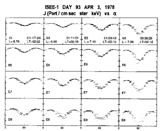 |
Fig. 9. An example of detailed electron pitch angle distributions measured by the ISEE-1 satellite on April 3, 1978 close to the geomagnetic equator near the midnight meridian. The energy channels presented are 189-302 keV (E5), 302-477 keV (E6), 477-756 keV (E7), 756-1200 keV (E8) respectively. |
The radial profiles of the intensity of electrons and ions for pitch angles of 90o and 30o recorded during the ISEE-1 inbound orbit
from which the data of Figure 9 were extracted are shown in Figures 10 and 11 (Bhattacharjya and Fritz, 1998).
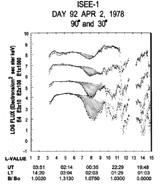 |
Fig. 10a. Radial profiles of electrons at two selected pitch angles of 90o and 30o measured by the inbound ISEE-1 satellite close to the geomagnetic equator near the midnight meridian on April 2-3, 1978. The energy channels presented are 22.5-39 keV (E1), 39-75 keV (E2), 75-120 keV (E3), 120-189 keV (E4) respectively. |
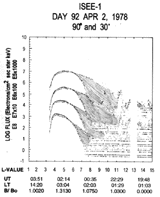 |
Fig. 10b. Same as Figure 10a but for the electron energy passbands presented in Figure 9. |
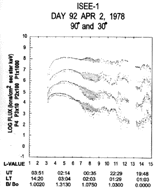 |
Fig. 11a. Same as Figure 10a but for the ion energy channels with the following passbands for protons: 24-44.5 keV (P1), 44.5-65.3 keV (P2), 65.3-95.5 keV (P3), 95.5-142 keV (P4) respectively. |
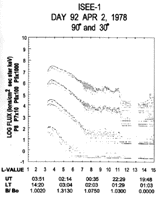 | Fig. 11b. Same as Figure 10a but for the ion energy channels with the following passbands for protons: 142-210 keV (P5), 210-333 keV (P6), 333-849 keV (P7), 849-2081 keV (P8) respectively. |
The shaded region indicates the region in which the butterfly distributions were observed. Note in Figure 10 that the electron profiles all show the presence of such butterfly distributions for the energy range covered [22.5 keV to 1.2 MeV] with the maximum difference between the 90o and 30o pitch angle intensity increasing with increasing energy. West, Buck, and Walton (1973) first observed these butterfly distributions in the electron pitch angle distributions in measurements made by the OGO-5 satellite. The distributions were observed all of the time when the satellite was close to the magnetic equator and beyond the geostationary orbit on the nightside of the magnetosphere. Those authors explained these distributions as being produced by the azimuthal drift of electrons conserving their first two adiabatic
invariants. The drift trajectories for these two different pitch angle particle
are shown in Figure 12 drawn from Lyons and Williams (1984).
Note that the small pitch angle particles will drift around the Earth at all radial distances associated with where the butterfly distributions were observed in Figures 10 and 11. This is not the case for the particles which mirror at the equator. They will follow drift paths which take them to the magnetopause over the region beyond 6 earth radii if they are near the midnight meridian.
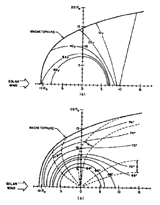 |
Fig. 12. Average magnetic field characteristics projected to the geomagnetic equatorial plane: (a) contours of constant magnetic field intensity: (b) contours in the equatorial plane of the latitude and local time of the point of intersection of a field line with the Earth's surface. An energetic particle with an equatorial pitch angle of 90o will following the constant B-field contours of (a) whereas a particle with a small equatorial pitch angle mirroring just above the atmosphere of Earth will essentially follow the solid contours in (b) as each of these particle types drift in longitude (azimuth). (from Lyons and Williams, 1984) |
Both electrons and ions will be affected in this manner, electrons drifting eastward into the dawn magnetopause and ions drifting westward into the dusk magnetopause. For such equatorially mirroring particles, this will be done in a manner independent of energy since their first invariant is equivalent to 1/B0. Why then does Figures 10 and 11 show an energy dependence to the fluxes of both electrons and ions. In fact the lowest energy ion channel [24 keV to 44.5 keV] actually shows an enhancement of the intensity of such ions in the region where other channels are demonstrating butterfly distributions. The most straightforward explanation of these observations is that the region just outside the magnetopause can act as a source of these ions and possibly electrons (Sheldon et al., 1998) as well as a sink. The energy dependence we observe is then a measure of the energy spectrum of the source for both of these particle species.
CONCLUSION
From the POLAR results shown here a mechanism in the polar cusp produces energetic particles from a thermalized solar wind population which can then become the source of a semi-permanent layer of energetic ions and electrons at the magnetopause and along its flanks that have been reported by many authors in the past. It follows logically that this energetic particle population has access to the inner magnetosphere along paths of constant magnetic field magnitude due to their gradient and curvature drifts, ions entering along the dawn flank of the magnetopause and electrons possibly entering along the dusk flank creating the observation of a variable equatorial pitch angle distribution which can give rise to a "butterfly type" distribution when the source is interrupted. When this population is present it then becomes the source population for subsequent radial diffusion and the populating of the radiation belts. When large transient variations occur in the upstream solar wind this mechanism can be the source of the ring current, initally the asymmetric ring current as particles enter the magnetosphere on one flank and exit on the other becoming the symmetric ring current as sufficient particles scatter to pitch angles permitting them to mirror further away from the equator so that they can complete a full drift around the magnetosphere. This is the transition between panels (a) and (b) of Figure 12.
ACKNOWLEDGEMENTS
The authors have benefited from the effort of and discussions with the following individuals in the preparation of this manuscript: Harlan Spence, Mohamed Alothman, Gina Gugliotti, Jyotirmoyee Bhattacharjya (all at Boston University), Stefano Livi (Max Planck Institute for Aeronomy),and Joe Fennell (Aerospace Crop.). Appreciation is expressed to Bern Blake (Aerospace), Jack Scudder (University of Iowa), and Chris Russell (UCLA) for the use of the various POLAR data sets and to Donald Williams (JHU/APL) for the use of the GEOTAIL EPICS data. The author wants to acknowledge the contribution to the POLAR CAMMICE sensor effort of Bryan Laubscher, Robert Hedges, Rose Vigil, and Gina Lujan at Los Alamos National Laboratory, Stefano Livi, Hartmut Sommer, and Eckhart Steinmetz at the Max Planck Institute for Aeronomy, Manuel Grande and his colleagues at the Rutherford Appleton Laboratory in the United Kingdom, Joe Fennell, Rocky Koga, Patty Lew, Norm Katz, Jim Roeder, and Bill Crain at the Aerospace Corporation. Much of this research was supported by NASA grants NAG5-2578 and NAG-7677.
REFERENCES
Baker, D. N. and E. C. Stone, The Magnetopause Energetic Electron Layer 1. Observations Along the Distant Magnetotail, J. Geophys Res., 83, No. A9, 4327 (1978).
Bhattacharjya, J. and T. A. Fritz, Statistics of Observed Butterfly Distributions in the Outer Nightside Magnetosphere, EOS, Trans. of AGU, 9, No. 17, S323 (1998).
Blanchard, G. T., L. R. Lyons, J. B. Blake, and F. J. Rich, SAMPEX observations of energetic electron precipitation in the dayside low-altitude boundary layer, J. Geophys Res., 103, No. A1,191 (1998).
Chen, J., T. A. Fritz, R. B. Sheldon, H. E. Spence, W. N. Spjeldvik, J. F. Fennell, S. Livi , A new temporarily confined population in the polar cap during the August 27, 1996 geomagnetic field distortion period, Geophys. Res. Lett., 24, 1446 (1997).
Chen, J., T. A. Fritz, R. B. Sheldon, H. E. Spence, W. N. Spjeldvik, J. F. Fennell, S. Livi, C. T. Russell, J. S. Pickett, and D. A. Gurnett, Cusp energetic particle events: Implication for a major acceleration region of the magnetosphere, J. Geophys Res., 103, No. A1, 69 (1998).
Chen, J. and T. A. Fritz, Features of the cusp energetic particle events, Adv. Space Res., (in press) (1998a).
Chen, J. and T. A. Fritz, Correlation of cusp MeV helium with turbulent ULF power spectra and its implications, Geophys. Res. Lett., 25, 4113 (1998b).
Cornwall, J. M., Transport and loss processes for magnetospheric helium, J. Geophys Res., 76, 264 (1971).
Frank, L. A., J. A. Van Allen, and J. D. Craven, Large diurnal variations of the geomagnetically trapped and of precipitated electrons observed at low altitudes, J. Geophys Res., 69, No 15, 3155 (1964).
Fritz, T. A., Study of the high-latitude, outer-zone boundary region for > 40 keV electrons with satellite Injun 3, J. Geophys Res., 75, 5387 (1970).
Fritz, T. A., C. W. Arthur, J. B. Blake, P. J. Coleman, J. P. Corrigan, W. D. Cummings, S. E. DeForest, K. N. Erickson, A. Konradi, W. Lennartsson, A. J. Masley, B. H. Mauk, C. E. McIlwain, R. L. McPherron, G. A. Paulikas, K. A. Pfitzer, D. L. Reasoner, P. R. Satterblom, S. Y. Su, R. J. Walker, E. C. Whipple, B. Wilken, J. R. Winckler, Significant Initial Results from the Environmental Measurements Experiment on ATS-6, NASA Technical Paper 1101, NASA Scientific and Technical Information Office, Washington, DC, 34 p. (1977).
Fritz, T. A., J. Chen, R. B. Sheldon, H. E. Spence, J. F. Fennell, S. Livi, C. T. Russell, and J. S. Pickett, Cusp energetic particle events measured by POLAR spacecraft, Phys. Chem. Earth (C), 24, 135-140 (1999).
Lyons, L. R. and D. J. Williams (1984); Quantitative aspect of the Magnetospheric Physics, Dordrecht; Boston: D. Reidel Pub. Co.; Hingham, MA, U.S.A., 231 p. (1984).
Meng, C. I. and K. A. Anderson, A layer of energetic electron (> 40 keV) near the magnetopause, J. Geophys Res., 75, 1827 (1970).
Mitchell. D. G., F. Kutchko, D. J. Williams, T. E. Eastman, L. A. Frank, and C. T. Russell, An extended study of the low-latitude boundary layer on the dawn and dusk flanks of the magnetosphere, J. Geophys Res., 92, No. A7, 7394 (1987).
Sarris, E. T., S. M. Krimigis, and T. P. Armstrong, Observation of magnetospheric bursts of high-energy protons and electrons at ~ 35 R with IMP 7, J. Geophys Res., 81, No. A13, 2341 (1976).
Sheldon, R. B., H. E. Spence, J. D. Sullivan, T. A. Fritz, and J. Chen, The discovery of trapped energetic electrons in the outer cusp, Geophys. Res. Lett., 25, 1825 (1998).
Spjeldvik, W. N. and T. A. Fritz, Composition of hot plasmas in the inner magnetosphere: Observations and theoretical analysis of protons, helium ions, and oxygen ions", in Space Research VIII, ed. by M. J. Rycroft and A. C. Strickland, Oxford, Eng., Pergamon Press, 317 (1978).
Tverskoy, B. A., Transport and acceleration of particles in the Earth's magnetosphere, Geomangn. Aeron., 5, 617 (1965).
Tverskoy, B. A., Electric fields in the magnetosphere and the origin of trapped radiation, Solar Terrestrial Physics, Dyer(ed), D. Riedel, Dordrecht, 297-317 (1970).
West, H. I., Jr., R. M. Buck and J. R. Walton, Electron pitch angle distributions of energetic electrons throughout the magnetosphere as observed by OGO-5, J. Geophys Res., 78, 1064 (1973).
Williams, D. J., D. G. Mitchell, T. E. Eastman, and L. A. Frank, Energetic particle observation in the low latitude boundary layer, J. Geophys Res., 90, 5097 (1985).
Williams, D. J. et al., GEOTAIL energetic particles and ion composition instrument, J. Geomag. Geoelectr., 46, 39-57, (1994).